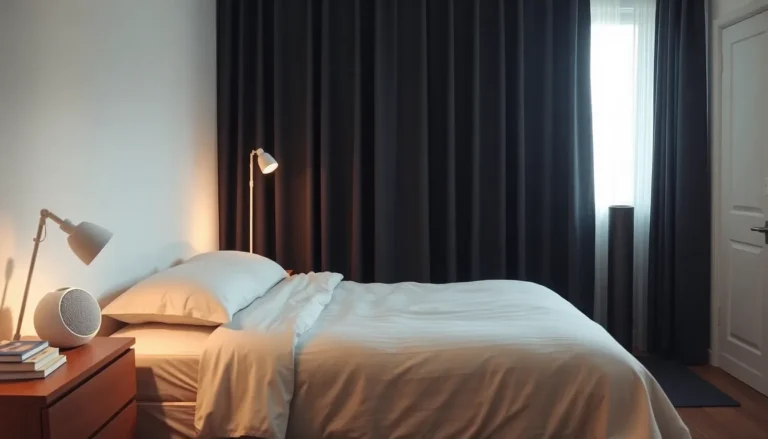Finding the right home insurance can feel overwhelming. With so many options available, it’s crucial to choose a policy that not only fits a budget but also provides adequate protection for one’s most valuable asset. Homeowners face unique risks, from natural disasters to theft, making comprehensive coverage essential.
The best home insurance policies offer a blend of affordability and robust coverage. They protect against common risks while providing peace of mind. Understanding the key features and benefits of various policies can empower homeowners to make informed decisions. This guide will explore top-rated home insurance options, helping readers navigate the landscape and secure the best protection for their homes.
Table of Contents
ToggleUnderstanding Home Insurance
Home insurance offers financial protection against damages and losses to property and personal belongings. Understanding its components and options helps homeowners choose the best policy for their needs.
What Is Home Insurance?
Home insurance, also known as homeowners insurance, is a contract between a policyholder and an insurance company. This contract provides coverage against events like fire, theft, and certain natural disasters. Home insurance typically covers the home’s structure, personal property, liability for injuries on the property, and additional living expenses if the home becomes uninhabitable due to covered damages.
Types of Home Insurance Policies
- HO-1 (Basic Form): This policy covers a limited number of perils, including fire, lightning, and theft. It offers minimal protection and is less common.
- HO-2 (Broad Form): HO-2 policies provide coverage for a broader range of perils than HO-1. This includes additional risks like falling objects and the weight of snow.
- HO-3 (Special Form): The most common type of policy, HO-3 covers the home structure against all perils, except those specifically excluded. It also covers personal property against named perils.
- HO-4 (Renters Insurance): Designed for tenants, HO-4 covers personal property and liability but not the building structure itself.
- HO-5 (Comprehensive Form): HO-5 offers extensive coverage for both structure and personal property, covering all perils not explicitly excluded.
- HO-6 (Condominium Insurance): Tailored for condo owners, HO-6 covers personal property, liability, and any improvements made to the unit.
- HO-7 (Mobile Home Insurance): This policy covers mobile or manufactured homes, offering similar coverage to HO-3 policies.
- HO-8 (Older Home Insurance): Specifically for older homes, HO-8 covers the home value based on repair costs rather than market value, accommodating the unique needs of such properties.
Factors to Consider for the Best Home Insurance

Homeowners must evaluate several factors when selecting the best home insurance policy. Understanding coverage options, premium costs, and deductibles helps ensure adequate protection without overspending.
Coverage Options
Coverage options vary significantly among policies. Homeowners should assess the specific types of coverage available in their chosen policy. Common coverage features include:
- Dwelling Coverage: Protects the structure and attached additions against risks, including fire and water damage.
- Personal Property Coverage: Covers personal belongings, such as furniture and electronics, from theft or damage.
- Liability Protection: Offers financial protection against legal claims resulting from injuries or property damage on the insured property.
- Additional Living Expenses (ALE): Covers temporary living costs if a home becomes uninhabitable due to a covered loss.
Homeowners must ensure their policy addresses unique risks based on their location, like flood or earthquake coverage.
Premium Costs
Premium costs significantly influence policy selection. Factors affecting premiums include:
- Location: Areas prone to natural disasters or high crime rates often feature higher premiums.
- Home Value: Higher-valued homes typically incur greater coverage costs.
- Claims History: Homeowners with multiple claims can face increased premiums due to perceived risk.
- Credit Score: Insurers often use credit scores to help determine premiums.
Comparing quotes from multiple providers can lead to a more affordable policy with suitable coverage.
Deductibles
Deductibles determine the amount homeowners pay out of pocket before the insurance coverage kicks in. Key points regarding deductibles include:
- Amount: Deductibles typically range from $500 to $2,000, with higher deductibles generally leading to lower premiums.
- Type: Homeowners can choose between flat deductibles and percentage deductibles based on the claim amount.
- Impact on Claims: A higher deductible can result in significant savings on premium costs, but it increases financial responsibility in the event of a claim.
Evaluating deductibles in relation to personal financial situations ensures homeowners select a manageable option.
Top Home Insurance Providers
Choosing from the leading home insurance providers ensures homeowners access to comprehensive coverage at competitive prices. Below are three top-rated suppliers, each offering unique benefits to meet different needs.
Provider 1
State Farm
State Farm ranks as one of the largest home insurance providers in the United States. It offers customizable coverage options, including dwelling, personal property, and liability coverage. Homeowners can take advantage of numerous discounts, such as for bundled policies or claims-free history. State Farm also provides a user-friendly app for easy policy management.
Provider 2
Allstate
Allstate stands out for its extensive coverage options and over 85 years of experience. Customers can choose from policies like the Allstate Standard or their unique Enhanced policy, which includes personal property replacement cost coverage. Allstate’s Claim Satisfaction Guarantee ensures responsive customer support during the claims process, enhancing overall service satisfaction.
Provider 3
Amica Mutual
Amica Mutual is known for exceptional customer service and highly rated policy satisfaction. It offers all-in-one policies, which cover various home types, including condos and rentals. Amica allows for multiple discounts such as loyalty and claim-free discounts, which can contribute to lower premium costs. Their transparent website facilitates easy coverage comparisons and claims management for homeowners.
Customer Reviews and Ratings
Customer reviews and ratings play a vital role in the home insurance selection process. These insights help potential policyholders gauge the performance and reliability of various insurance providers.
Importance of Customer Feedback
Customer feedback reflects real-life experiences with home insurance providers. Positive reviews indicate satisfaction with claim handling, customer service, and policy options, while negative reviews highlight common issues. Evaluating customer feedback helps homeowners identify providers that prioritize client needs and maintains transparency in interactions. A provider with a high volume of favorable reviews demonstrates responsiveness and commitment to customer satisfaction.
Analyzing Ratings
Analyzing ratings from reputable sources provides an objective view of a provider’s performance. Sources like J.D. Power, A.M. Best, and Consumer Reports offer ratings based on criteria such as claims processing, customer satisfaction, and financial stability.
| Rating Source | Key Criteria | Significance |
|---|---|---|
| J.D. Power | Customer satisfaction, claims handling | Measures overall customer experience |
| A.M. Best | Financial strength, credit ratings | Indicates reliability and performance |
| Consumer Reports | Policy features, pricing | Compares value and coverage options |
Homeowners should consider both ratings and reviews to choose the best home insurance policy. This approach combines qualitative insights with quantitative data, offering a comprehensive understanding of a provider’s reputation and service quality.
Choosing the right home insurance is essential for safeguarding one’s most valuable asset. By understanding the various policy types and coverage options available homeowners can tailor their insurance to meet specific needs. Evaluating factors like premium costs and deductibles alongside customer feedback allows for informed decisions.
With top providers like State Farm, Allstate, and Amica Mutual offering unique advantages homeowners have the opportunity to find a policy that fits their budget and coverage requirements. Taking the time to research and compare options ensures adequate protection against unexpected events, ultimately providing peace of mind.




